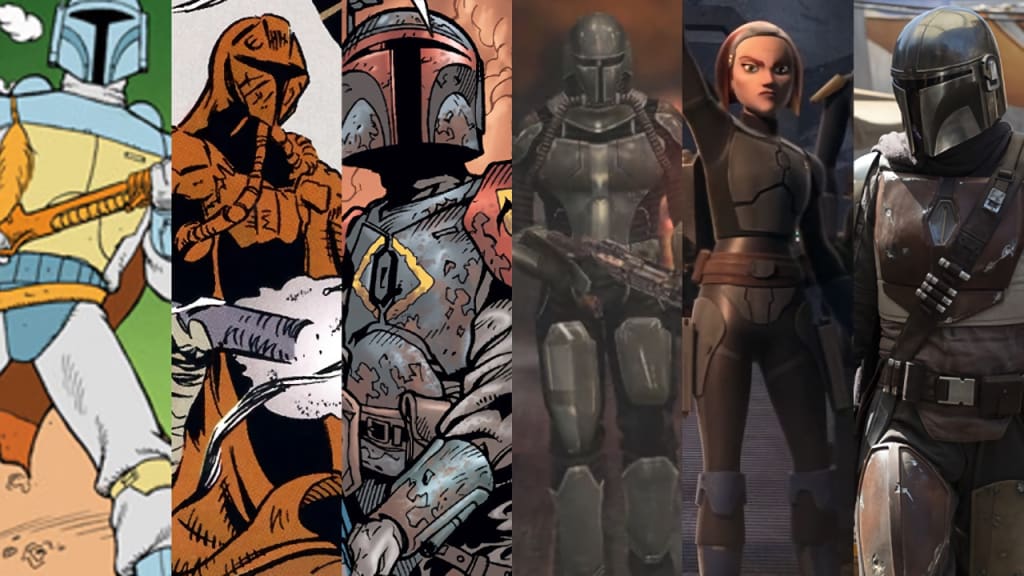How Mandalorian Lore Evolved Over 40 Years of 'Star Wars' Storytelling
What A Long Way We've Come

Between the major factions of the Star Wars universe, the Jedi and the Sith, the Republic and the Separatists, or the Rebel Alliance and the Empire, there have always been those in the middle: big corporations like the Techno Union and the Banking Clan, or crime syndicates like the Hutts, Black Sun, and Crimson Dawn.
And of course, the Mandalorians.
We got our first glimpse on their legendary armor in the animated short “The Story of the Faithful Wookiee” – probably the only watchable part of the Star Wars Holiday Special. The first mention of the name Mandalorian stems from Donald F. Glut’s novelization of The Empire Strikes Back, where he describes them as "…a group of evil warriors defeated by the Jedi Knights during the Clone Wars.” This was later retconned, but this brief description already showed what laid at the heart of the Mandalorian culture.
The Expanded Universe had painted quite an extensive picture of the history for these warriors. More than 7,000 years before the events of A New Hope, the species that would become the Mandalorians were grey-skinned aliens called Taung, who lived on Coruscant until a volcanic eruption forced them to leave the planet. When Mandalore the First and his troops conquered a planet, he gave it the name Mandalore and called his people the Mandalorians. Soon after, they started invading other planets in the same sector, slowly building a reputation as mighty warriors. More than 3,000 year later, the leader of the Mandalorians was defeated by the former Jedi Ulic Qel-Droma, leading to the first coalition between the Mandalorians and the Sith and their joint fight against the Jedi and the Republic. During the course of the next thousand years the Mandalorians fought both with the Sith against the Republic and the Jedi, but both sides more or less saw them just as useful tools to achieve their goals, and not as their equals. So after being defeated once more many Mandalorians chose to become bounty hunters or mercenaries, leading to a fractioning into many smaller houses and clans, who often fought one another.
The Mandalorians often integrated other species into their midst, either after conquering them or after they joined them voluntarily in hope of a better life. So being a Mandalorian was neither a birthright nor the result of being born on Mandalore, but something that had to be earned by following their culture and their way of living.
After the fall of the Empire the Mandalorians fought for the New Republic. In fact, the Legacy of the Force novel series depicted how Boba Fett trained Jaina Solo, Han and Leia’s daughter, so that she could defeat her brother Jacen, after he had fallen to the Dark Side. All these stories, told in numerous books and comics, became rebranded as Legends in 2014. However, a kind of schism had already happened in Star Wars storytelling before that.
Karen Traviss played a major part in the creation of the Mandalorian culture in Star Wars literature. Between 2004 and 2009 she had four Republic Commando and one Imperial Commando novels published. The books not only dealt with the clone and storm troopers, respectively, but also involved Mandalorians, their culture and way of living, and their homeworld. Aside from these novels she wrote several short stories and an article about the Mandalorian people and culture for Star Wars Insider. She was also responsible for developing the Mandalorian language Mando’a.
Traviss based her characteristic of the Mandalorians on their image as ruthless warriors, who conquered other worlds and often cause extinction of complete species and populations that dared to stand in their way. At the same time, she showed them as caring egalitarian people, who regarded men and women as absolute equals, where girls could become the same kind of mighty fighters as boys. Mandalorian families adopted orphans and helped widows, who lost their husband in war.
When George Lucas and Dave Filoni made two major changes when they decided to introduce the Mandalorians in season 2 of The Clone Wars. First, they decided that the planet Mandalore had been devasted by some cataclysmic event in the past, forcing the people to live under large domes in order to survive. Second, major parts of the population, called the New Mandalorians, had left their aggressive past behind them, becoming peaceful people under the leadership of Satine Kryze. Only a small faction, called the Death Watch, were still hanging on to the aggressive warrior ways. Both aspects contradicted heavily with everything that Traviss had written of “her” Mandalorians, and so she decided to part ways with Lucasfilm and Star Wars as a whole, leaving her planned second Imperial Commando novel canceled.
Later seasons of The Clone Wars, Star Wars Rebels, and of course, The Mandalorian continued the story of Mandalore and its people, based on the decisions that were made by Lucas and Filoni in 2009. After the fall of the Republic, Bo-Katan Kryze became leader of Mandalore, but she refused to follow Palpatine’s orders and was replaced by Gar Saxon, a member of Death Watch. Later Clan Saxon clashed with Clan Kryze and Clan Wren. Bo-Katan would later claim the Darksaber, which had become a symbol of the ruler of Mandalore. The Darksaber was an ancient weapon, that had been created by Tarre Vizsla, the first Mandalorian to become a Jedi Knight. Realizing that they would never be able to subdue the Mandalorians, the Empire staged the “Great Purge” in which many Mandalorians were killed, and the survivors went into hiding. The Darksaber fell into the hands of the Imperial Moff Gideon.
Until Din Djarin took it from him, after defeating the Imperial in a one-on-one fight…
Written By Gerald Petschk
Sources: Star Wars Insider Issue 80 and Issue 86
Syndicated From Culture Slate






Comments
There are no comments for this story
Be the first to respond and start the conversation.